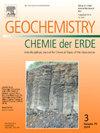连云山杂岩花岗伟晶岩的成因:磷灰石和白云母化学的启示
IF 2.9
3区 地球科学
Q2 GEOCHEMISTRY & GEOPHYSICS
引用次数: 0
摘要
湘东北江南造山带是华南地块稀有金属矿产资源最重要的地区之一。连云山以丰富的Li-Be-Nb-Ta花岗伟晶岩矿床而闻名,但连云山伟晶岩的岩浆形成过程尚不清楚。通过锆石LA-ICP-MS UPb定年、全岩主微量元素地球化学、白云母和磷灰石原位微量元素分析,对连云山杂岩体和伟晶岩的不同岩性进行了研究。这些实验为研究该地区富锂伟晶岩形成机制提供了独特的见解。阐明了连云山地区伟晶岩的成因及富锂伟晶岩与花岗岩的关系。锆石UPb测年结果显示,黑云母二长花岗岩的协和年龄分别为147.4±0.69 Ma,二云母二长花岗岩的协和年龄分别为145.5±0.73 Ma和144.0±1.3 Ma。全岩地球化学分析表明,花岗岩和伟晶岩具有明显的分馏结晶特征。连云山地区白云母中Rb、Cs、Ta含量呈递增趋势,而Nb/Ta、Li/Rb、K/Cs、K/Rb比值呈递减趋势,顺序为BMG→TMG→伟晶岩→锂辉石伟晶岩。这些趋势表明不同程度的分异结晶,其中伟晶岩和锂辉岩伟晶岩代表更演化的岩浆分异产物。使用白云母成分进行的分馏结晶模拟支持瑞利分馏过程,其中初始的花岗质熔体逐渐演化形成TMG、伟晶岩,最终形成锂辉石伟晶岩。磷灰石可分为岩浆型和热液型,均为氟磷灰石。磷灰石的稀土元素分布模式与全岩趋势一致。然而,来自锂辉石伟晶岩和其他伟晶岩的磷灰石表现出异常的REE模式。从BMG→TMG→伟晶岩到锂辉石伟晶岩,磷灰石中Sr含量降低(23 ~ 617 ppm), REE含量增加(1001 ~ 3159 ppm)。TMG中的磷灰石和伟晶岩具有相似的微量元素特征,与白云母模拟中观察到的分选趋势一致。相对较低SiO₂含量(65 ~ 70 wt%)的伟晶岩中磷灰石的REE浓度降低,Eu/Eu*(0.01 ~ 0.7)和La/Yb(0.1 ~ 26)比值显著升高。这表明伟晶岩的形成与斜长石的分解和富ree矿物的分离结晶有关。本文章由计算机程序翻译,如有差异,请以英文原文为准。
Petrogenesis of granitic pegmatite from the Lianyunshan complex, South China: Insights from apatite and muscovite chemistry
The Jiangnan Orogenic Belt (JOB) in the Northeastern Hunan Province (NHP), the one of the most significant regions for rare metal mineral resources in South China Block (SCB). It is renowned for abundant Li-Be-Nb-Ta granitic pegmatite deposits, However, the magmatic process of the Lianyunshan pegmatites remain poorly understood. This study focuses on various lithologies of the Lianyunshan complex pluton and pegmatite through zircon LA-ICP-MS U![]() Pb dating, whole-rock major and trace element geochemistry, and in situ trace element analyses of muscovite and apatite. These experiments offer unique insights into the mechanisms driving lithium-enriched pegmatite formation in this region. We elucidated the genesis of pegmatite and the relationship between Li-rich pegmatite and granite in Lianyunshan region. Zircon U
Pb dating, whole-rock major and trace element geochemistry, and in situ trace element analyses of muscovite and apatite. These experiments offer unique insights into the mechanisms driving lithium-enriched pegmatite formation in this region. We elucidated the genesis of pegmatite and the relationship between Li-rich pegmatite and granite in Lianyunshan region. Zircon U![]() Pb dating yielded the concordia ages of 147.4 ± 0.69 Ma for biotite monzonitic granite, 145.5 ± 0.73 Ma and 144.0 ± 1.3 Ma for two-mica monzonitic granite, respectively. The whole rock geochemical analyses reveal that granites and pegmatites exhibit obvious characteristic of fractional crystallization. In situ trace element analysis for muscovite reveal Rb, Cs, Ta concentrations increase progressively but the ration of Nb/Ta, Li/Rb, K/Cs, and K/Rb decrease in sequence of BMG → TMG → pegmatite→spodumene pegmatite in Lianyunshan region. These trends indicate varying degrees of fractional crystallization, with pegmatites and spodumene pegmatites representing more evolved magmatic differentiation products. Fractional crystallization simulation using muscovite compositions supports a rayleigh fractionation process, wherein the initial granitic melt progressively evolved to form TMG, pegmatites, and ultimately spodumene pegmatites. Apatite can be divided into magmatic and hydrothermal types, both identified as fluorapatite. The rare earth element (REE) distribution patterns of apatite are consistent with whole-rock trends. However, apatite from spodumene pegmatites and some other pegmatites exhibit anomalous REE patterns. From BMG → TMG → pegmatites to spodumene pegmatites, Sr content (23–617 ppm) in apatite decreases while REE content increases (1001–3159 ppm). Apatite in TMG, and pegmatites share similar trace element characteristics, consistent with the fractionation trends observed in muscovite modeling. Apatite from pegmatites with relative lower SiO₂ content (65–70 wt%) show reduced REE concentrations and significantly elevated Eu/Eu* (0.01–0.7) and La/Yb (0.1–26) ratios. This suggests that pegmatite formation involved plagioclase decomposition and separation crystallization of HREE-enriched minerals.
Pb dating yielded the concordia ages of 147.4 ± 0.69 Ma for biotite monzonitic granite, 145.5 ± 0.73 Ma and 144.0 ± 1.3 Ma for two-mica monzonitic granite, respectively. The whole rock geochemical analyses reveal that granites and pegmatites exhibit obvious characteristic of fractional crystallization. In situ trace element analysis for muscovite reveal Rb, Cs, Ta concentrations increase progressively but the ration of Nb/Ta, Li/Rb, K/Cs, and K/Rb decrease in sequence of BMG → TMG → pegmatite→spodumene pegmatite in Lianyunshan region. These trends indicate varying degrees of fractional crystallization, with pegmatites and spodumene pegmatites representing more evolved magmatic differentiation products. Fractional crystallization simulation using muscovite compositions supports a rayleigh fractionation process, wherein the initial granitic melt progressively evolved to form TMG, pegmatites, and ultimately spodumene pegmatites. Apatite can be divided into magmatic and hydrothermal types, both identified as fluorapatite. The rare earth element (REE) distribution patterns of apatite are consistent with whole-rock trends. However, apatite from spodumene pegmatites and some other pegmatites exhibit anomalous REE patterns. From BMG → TMG → pegmatites to spodumene pegmatites, Sr content (23–617 ppm) in apatite decreases while REE content increases (1001–3159 ppm). Apatite in TMG, and pegmatites share similar trace element characteristics, consistent with the fractionation trends observed in muscovite modeling. Apatite from pegmatites with relative lower SiO₂ content (65–70 wt%) show reduced REE concentrations and significantly elevated Eu/Eu* (0.01–0.7) and La/Yb (0.1–26) ratios. This suggests that pegmatite formation involved plagioclase decomposition and separation crystallization of HREE-enriched minerals.
求助全文
通过发布文献求助,成功后即可免费获取论文全文。
去求助
来源期刊

Chemie Der Erde-Geochemistry
地学-地球化学与地球物理
CiteScore
7.10
自引率
0.00%
发文量
40
审稿时长
3.0 months
期刊介绍:
GEOCHEMISTRY was founded as Chemie der Erde 1914 in Jena, and, hence, is one of the oldest journals for geochemistry-related topics.
GEOCHEMISTRY (formerly Chemie der Erde / Geochemistry) publishes original research papers, short communications, reviews of selected topics, and high-class invited review articles addressed at broad geosciences audience. Publications dealing with interdisciplinary questions are particularly welcome. Young scientists are especially encouraged to submit their work. Contributions will be published exclusively in English. The journal, through very personalized consultation and its worldwide distribution, offers entry into the world of international scientific communication, and promotes interdisciplinary discussion on chemical problems in a broad spectrum of geosciences.
The following topics are covered by the expertise of the members of the editorial board (see below):
-cosmochemistry, meteoritics-
igneous, metamorphic, and sedimentary petrology-
volcanology-
low & high temperature geochemistry-
experimental - theoretical - field related studies-
mineralogy - crystallography-
environmental geosciences-
archaeometry
 求助内容:
求助内容: 应助结果提醒方式:
应助结果提醒方式:


